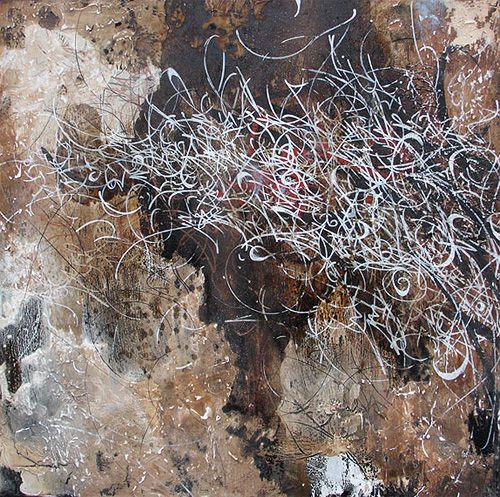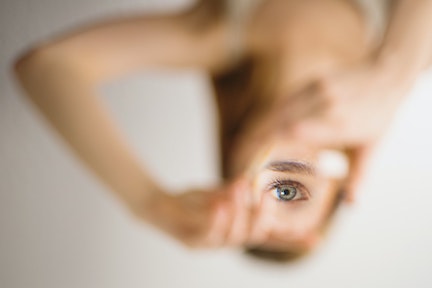by: Cole Heinowitz ((Header art sourced from the incredibly talented Nandipha Mntambo’s exhibition entitled, “Kufa nekuvuka kwelutsandvo.”))
Cole Heinowitz’s poetry performs a necessary alchemy. Forget iron to gold, her work is concerned with the transformation of ourselves into language and back again. Menelaus sought truth by holding fast to Proteus; Heinowitz seeks the same clarity by “trying to organize bodies according to the pattern that ends human suffering.”
CRUSTACEANS BEING BRED
They were going to start the world all over again in Africa but they needed to have industry. The biggest above-board industries of the old world were sausage production and shellfish processing. Huge cement flats everywhere were filled with one food product or the other, and the sun had filled the sausage flats with enormous, yellowed, swarming maggots, and the crustacean flats were alive with spiders and the non-aquatic brethren of crabs, which were interbred with or devoured by one another. It was a rancid job and the workmen used massive trowels and all of them were sick with skin rot, and sometimes they just had to hose the beasts down to prevent them from lunging. In the new world, they are going to economize: only the seaside hotel industry, now a minor breadwinner, will survive, but the guests will be cross-bred with prawns and grubs, among other things, the lower manifestations of these operations pouring in through their windows every time the tide rises.
One day we found a rotting grapefruit on the inside of the sliding glass patio door, kelp and mites stuck to it. The next day the delicate balance of mutation had shifted and we were fish with the noses of dolphins. We were sequestered in the basement in buckets and dumped from the exposed and rusty rebar into trawling pools to serve as bait for the once-lowly crustaceans, our ancestors. We were not so easily subdued, however, and began eating the crustaceans intended to eat us. This was part of a cruelly engineered program. As soon as they were inside us, the crustaceans began to breed in our organs, making rotten foam rubber pills of our intestines, breeding and rotting, until our skin was too tight and came off as if flayed when we flexed, our flanks writhing with worms and bits of unidentifiable machinery. In this form, we were cast back up onto the cement floor to be harvested. Even the hardiest workmen, much-improved versions of the old world seamen, felt their stomachs revolt against the work. We were dipped in lye solution and our snouts broke off so we couldn’t talk. Then we knew there was no chance of our ever ruling the earth again, as humans once had. We ran pointlessly for our lives through the mammoth hotel basement, up into the lobby, and out onto the forbiddingly chaotic African motorway.
ART CAVE
It started in the theater. I began as an audience member, worked briefly as an usher, then ended up on the stage. A terrifying bible salesman would preach Armageddon in front of the fire exit during all our performances, but there were ancient Croatian witches in the audience who knew how to read such intimidation tactics as drama.
The witches knew that the prancing manipulator by the exit and the girl volunteer running grips from the wings were, in fact, the protagonists. The actors ran through the aisles, disrupting the action, and only those who knew our secret saw us. We were sharks, tapered and glistening. The male shark lunged and I gave birth from the wound he made above my right hipbone. The baby shark was gorgeous, all slathered in tiny diamonds.
One day the witches disappeared. I was a person again and my beautiful baby shark was invisible and could frolic in the air.
I left the theater and went to the art cave hidden under the flower display in the park, behind the military records office, just past the fishpond at the entrance to the highway. For centuries, musicians and lunatics have snuck through a perilous gap in the window of the military archive. There’s easier access by hopping the fence along Main Street, but no one seems to remember this.
What’s stranger: the cave isn’t even hidden. From the bustling street a passerby could look directly inside and descry its mysteries, but in 400 years this has never happened. This total exposure combined with the inviolate sanctity of the cave is the first discomfort an initiate gets over. There’s also the reek and the green scum, along with the smashed German biplane that confuses the poets that come to pay homage.
In the cave, eight of us enter into trances looking for the right album (there’s a collection of rare ‘78s) and trying to organize bodies according to the pattern that ends human suffering. But the trances themselves are painful. We rend our clothes to find the answer on the paisley lining of a sports coat and deface works of art, scratching out features to approximate the planar face of peace. In the end, we’re splayed on the ground in a hexagon while one person beats like a heart in the middle. The evil-mongers bound in the rock wall and barred by a stove cry out and whoever we are, we open our eyes to a moment without war.
THE HAUNTS
The haunts listen into my rhythms. Every time my body is busied, the haunts flash their low motor rumbling. Then they suck themselves back in when I grow still. There is a big clamor that I associate with nervousness before there is that nothing again. The haunts, I’m yelling continuously, blustering around, blossom from the darkened notch.
Cole Heinowitz is the author of two books of poetry, Daily Chimera (Incommunicado, 1995) and The Rubicon (The Rest, 2008), the chapbook, Stunning in Muscle Hospital (Detour, 2002), and the critical study, Spanish America and British Romanticism, 1777-1826: Rewriting Conquest (Edinburgh University Press, 2010). She is the co-translator of Mario Santiago Papasquiaro’s Advice from 1 Disciple of Marx to 1 Heidegger Fanatic (Wave Books, 2013) and The Selected Late Letters of Antonin Artaud, 1945-1947 (Portable Press @ Yo-Yo Labs, 2014). Her poems, essays, and translations have appeared in journals including Fence, The Poker, The Brooklyn Rail, HOW2, 6X6, Clock, Mirage 4 Period(ical), Aufgabe, The Poetry Project Newsletter, European Romantic Review, Dolce Stil Criollo, Two Lines, and Riot of Perfume. Her work has also been published online in Jacket, The Poems and Poetics Blog, and The Poetry Society of America’s series “In the Own Words.” Cole teaches literature at Bard College and lives in the Catskills.






